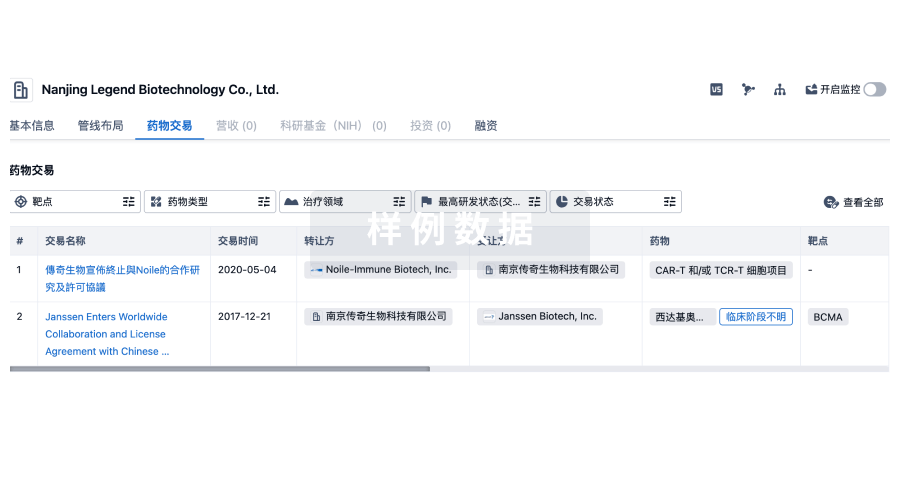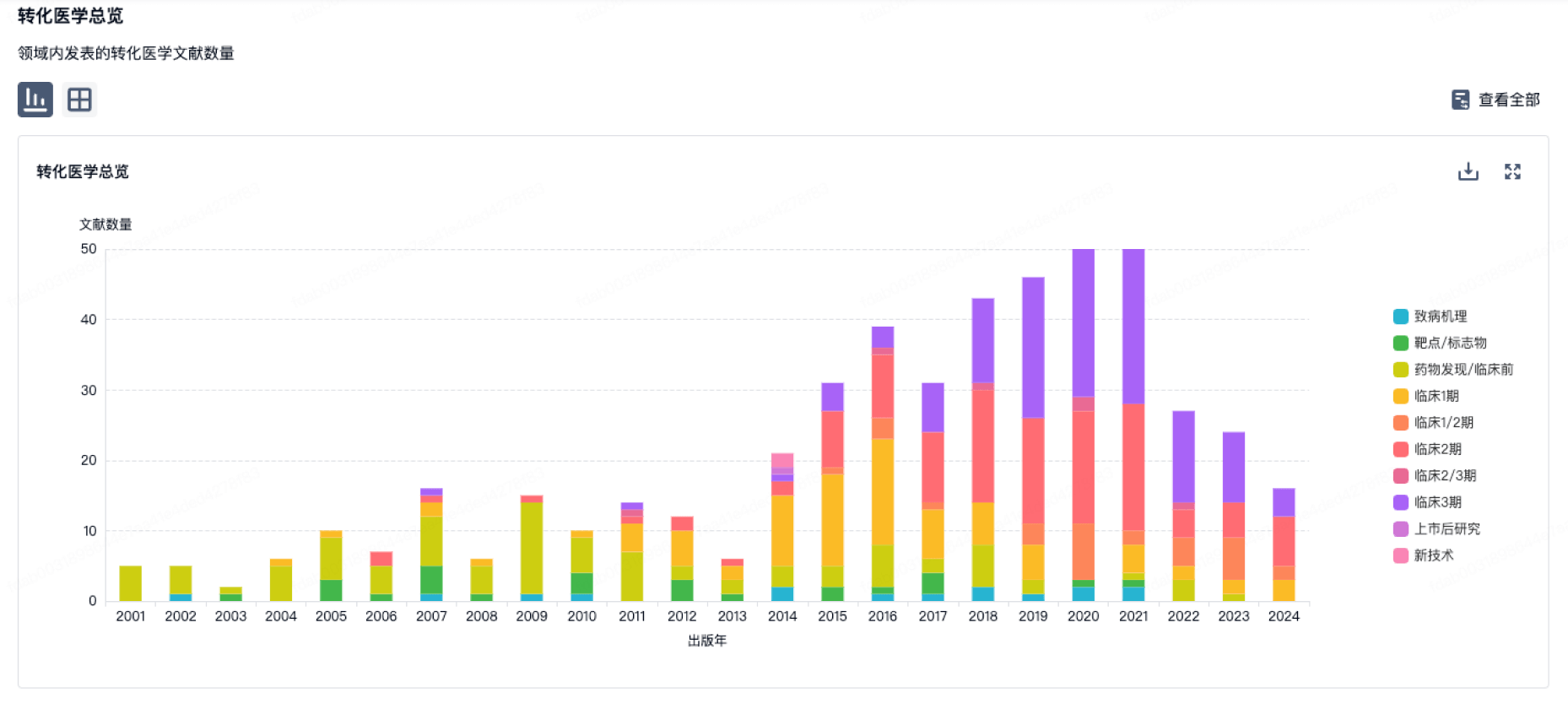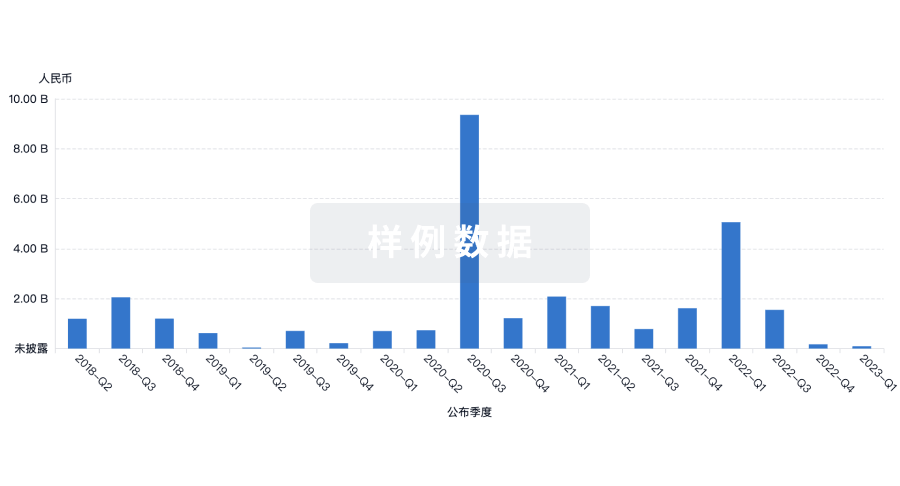预约演示
更新于:2025-11-27

The University of Western Australia
更新于:2025-11-27
概览
标签
其他疾病
神经系统疾病
皮肤和肌肉骨骼疾病
小分子化药
单克隆抗体
疾病领域得分
一眼洞穿机构专注的疾病领域
暂无数据
技术平台
公司药物应用最多的技术
暂无数据
靶点
公司最常开发的靶点
暂无数据
| 排名前五的药物类型 | 数量 |
|---|---|
| 小分子化药 | 2 |
| 单克隆抗体 | 1 |
关联
3
项与 The University of Western Australia 相关的药物作用机制 5-HT2A receptor激动剂 |
原研机构 |
最高研发阶段临床3期 |
首次获批国家/地区- |
首次获批日期- |
WO2023092195
专利挖掘作用机制- |
非在研适应症- |
最高研发阶段药物发现 |
首次获批国家/地区- |
首次获批日期- |
WO2023092177
专利挖掘作用机制- |
原研机构 |
非在研适应症- |
最高研发阶段药物发现 |
首次获批国家/地区- |
首次获批日期- |
292
项与 The University of Western Australia 相关的临床试验NCT06461429
Platform for Adaptive Trials in Perinatal Units (Core Protocol)
PLATIPUS is an adaptive platform trial aimed at improving the health of infants born preterm (before 37 weeks' gestation). PLATIPUS will compare how different treatments and care provided to pregnant women and people at risk of preterm birth and infants born preterm affect infant health.
The main questions PLATIPUS aims to answer are:
1. What effect/s do different treatments/care provided to pregnant women and people at risk of preterm birth have on the health of their infants? (Pregnancy domains)
2. What effect/s do different treatments/care given to infants born preterm have on their health ? (Neonatal domains).
This registration record relates to the PLATIPUS Core (or 'master') protocol which provides guidance for the overall running of the trial. Additional appendices will outline the aims, questions, treatments, and activities for each separate research question (domain). Each Domain-Specific Appendix will be registered separately on ClinicalTrials.gov and will link to this record.
The main questions PLATIPUS aims to answer are:
1. What effect/s do different treatments/care provided to pregnant women and people at risk of preterm birth have on the health of their infants? (Pregnancy domains)
2. What effect/s do different treatments/care given to infants born preterm have on their health ? (Neonatal domains).
This registration record relates to the PLATIPUS Core (or 'master') protocol which provides guidance for the overall running of the trial. Additional appendices will outline the aims, questions, treatments, and activities for each separate research question (domain). Each Domain-Specific Appendix will be registered separately on ClinicalTrials.gov and will link to this record.
开始日期2025-11-01 |
申办/合作机构  University of Melbourne University of Melbourne [+10] |
NCT07189390
A Randomised Controlled Trial to Assess if a Probiotic Intervention Leads to Enhanced Immune Responses to Vaccination in Antibiotic-treated Infants (Bloom Infant Probiotic (BIP) Study)
The goal of this clinical trial is to investigate whether administering a probiotic (Infloran®) to infants who received antibiotics in the first 28 days of life can restore or enhance their immune response to routine vaccines.
Antibiotic use in the first weeks of life can lower the levels of beneficial gut bacteria, such as bifidobacteria, which play a key role in immune function. As a result, infants treated with antibiotics may produce fewer antibodies after routine vaccinations, leaving them less protected against infections.
The main questions this study aims to answer are:
* Does treatment with the probiotic Infloran® improve the geometric mean concentrations (GMCs) of anticapsular antibodies against at least 11 serotypes included in the pneumococcal conjugate vaccine (PCV20) in serum samples collected at 6 months of age compared with placebo in infants treated with antibiotics in the neonatal period?
* Does treatment with the probiotic Infloran® improve the GMCs for the pneumococcal conjugate vaccine (PCV20) at 12 months of age compared with placebo in infants treated with antibiotics in the neonatal period?
* Does treatment with the probiotic Infloran® improve the GMCs of other routine childhood vaccines at 6 and 12 months of age compared with placebo in infants treated with antibiotics in the neonatal period?
* Does treatment with the probiotic Infloran® increase the proportion of infants achieving seroprotective antibody levels for pneumococcal antigens compared to placebo in infants treated with antibiotics in the neonatal period?
* What are the differences in antigen specific T cell responses, flow cytometry, blood transcriptomics, and gut microbiota composition in the probiotic (Infloran®) vs placebo groups in infants treated with antibiotics in the neonatal period?
Researchers will compare infants who receive Infloran® (a probiotic containing Bifidobacterium bifidum and Lactobacillus acidphilus) with those who receive a placebo (which contains the same excipients as Infloran® but does not contain any bacterial strains).
Participants will:
* Be randomly assigned to receive either a 14-day course of probiotic Infloran® or a placebo.
* Provide blood samples (3-5 mL) at 6 weeks, 6.5 weeks (optional blood-draw for exploratory endpoint), 6 months and 12 months of age.
* Provide stool samples at four timepoints: prior to starting the intervention (probiotic/placebo), on day 7, on day 14 after completion of the study supplement, and prior to their first vaccination at 6 weeks of age.
* Receive routine vaccinations at 6 weeks, 4 months and 6 months in line with the National Immunisation Program
* Complete surveys to collect information regarding probiotic/placebo administration and vaccination related side effects
This study aims to recruit 360 infants to assess whether this probiotic treatment following antibiotic exposure improves the immunogenicity of vaccinations. The information from this study will improve our understanding of how probiotic intervention can support optimal immune responses to vaccination in early life. The findings could potentially influence public health strategies, offering a new way to support optimal vaccine responses in antibiotic-treated infants.
Antibiotic use in the first weeks of life can lower the levels of beneficial gut bacteria, such as bifidobacteria, which play a key role in immune function. As a result, infants treated with antibiotics may produce fewer antibodies after routine vaccinations, leaving them less protected against infections.
The main questions this study aims to answer are:
* Does treatment with the probiotic Infloran® improve the geometric mean concentrations (GMCs) of anticapsular antibodies against at least 11 serotypes included in the pneumococcal conjugate vaccine (PCV20) in serum samples collected at 6 months of age compared with placebo in infants treated with antibiotics in the neonatal period?
* Does treatment with the probiotic Infloran® improve the GMCs for the pneumococcal conjugate vaccine (PCV20) at 12 months of age compared with placebo in infants treated with antibiotics in the neonatal period?
* Does treatment with the probiotic Infloran® improve the GMCs of other routine childhood vaccines at 6 and 12 months of age compared with placebo in infants treated with antibiotics in the neonatal period?
* Does treatment with the probiotic Infloran® increase the proportion of infants achieving seroprotective antibody levels for pneumococcal antigens compared to placebo in infants treated with antibiotics in the neonatal period?
* What are the differences in antigen specific T cell responses, flow cytometry, blood transcriptomics, and gut microbiota composition in the probiotic (Infloran®) vs placebo groups in infants treated with antibiotics in the neonatal period?
Researchers will compare infants who receive Infloran® (a probiotic containing Bifidobacterium bifidum and Lactobacillus acidphilus) with those who receive a placebo (which contains the same excipients as Infloran® but does not contain any bacterial strains).
Participants will:
* Be randomly assigned to receive either a 14-day course of probiotic Infloran® or a placebo.
* Provide blood samples (3-5 mL) at 6 weeks, 6.5 weeks (optional blood-draw for exploratory endpoint), 6 months and 12 months of age.
* Provide stool samples at four timepoints: prior to starting the intervention (probiotic/placebo), on day 7, on day 14 after completion of the study supplement, and prior to their first vaccination at 6 weeks of age.
* Receive routine vaccinations at 6 weeks, 4 months and 6 months in line with the National Immunisation Program
* Complete surveys to collect information regarding probiotic/placebo administration and vaccination related side effects
This study aims to recruit 360 infants to assess whether this probiotic treatment following antibiotic exposure improves the immunogenicity of vaccinations. The information from this study will improve our understanding of how probiotic intervention can support optimal immune responses to vaccination in early life. The findings could potentially influence public health strategies, offering a new way to support optimal vaccine responses in antibiotic-treated infants.
开始日期2025-10-01 |
NCT06626438
Treatable Traits in Interstitial Lung Disease
The goal of this clinical trial is to learn if a personalised treatment model of care "treatable traits" can improve quality of life and disease progression in patients with interstitial lung disease.
The main question it aims to answer is, will providing a treatable traits model of care improve health-related quality of life (HRQoL) (primary outcome), symptoms, anxiety, physical activity, and body composition (secondary outcomes).
Researchers will compare the treatable traits model to standard of care.
Participants in both arms will complete surveys, a Dual-Energy X-Ray Absorptiometry (DEXA) and whole-body composition scan, lung function and blood tests. Those in the intervention (TT) arm will be seen in a multidisciplinary clinic where they are seen by an ILD doctor, physiotherapist, psychologist, and dietitian.
The main question it aims to answer is, will providing a treatable traits model of care improve health-related quality of life (HRQoL) (primary outcome), symptoms, anxiety, physical activity, and body composition (secondary outcomes).
Researchers will compare the treatable traits model to standard of care.
Participants in both arms will complete surveys, a Dual-Energy X-Ray Absorptiometry (DEXA) and whole-body composition scan, lung function and blood tests. Those in the intervention (TT) arm will be seen in a multidisciplinary clinic where they are seen by an ILD doctor, physiotherapist, psychologist, and dietitian.
开始日期2025-09-03 |
申办/合作机构 |
100 项与 The University of Western Australia 相关的临床结果
登录后查看更多信息
0 项与 The University of Western Australia 相关的专利(医药)
登录后查看更多信息
51,262
项与 The University of Western Australia 相关的文献(医药)2026-02-01·AMERICAN JOURNAL OF OPHTHALMOLOGY
Peripapillary Retinoschisis: The Expanded Spectrum and New Insights From Multimodal Imaging
Article
作者: Gupta, R Rishi ; Lupidi, Marco ; Jeffery, Rachael C Heath ; Ip, Jenny ; Cabral, Diogo ; Bestch, Devin ; Kalevar, Ananda ; Chhablani, Jay ; Choudhry, Netan ; Fung, Adrian T ; Branley, Michael ; Farag, Andrew ; Yang, Lucy Yi ; Freund, K Bailey ; Chilov, Michael ; Chen, Fred K ; Kalatzis, David ; Dhanji, Shanil ; Baumal, Caroline R ; Kam, Andrew W
PURPOSE:
To characterize and classify different forms of peripapillary retinoschisis (PPRS), and to clarify the nomenclature of this condition.
METHODS:
A retrospective, multicenter, multinational case series of PPRS was performed from August 2021 to September 2024. Cases were included if they demonstrated retinoschisis contiguous with and thought to be originating from the optic disc. Demographic and clinical data collected included age, gender, visual acuity, intraocular pressure, axial length, refraction and referring symptoms. Mandatory investigations included optical coherence tomography of the optic disc and macula with radial scans, color fundus photography, and fundus autofluorescence. Select cases underwent fundus fluorescein and/or indocyanine green angiography. Retinoschisis was characterized by the meridian in relation to the optic disc, layer(s) of the retina affected and associated conditions. A literature review was performed to identify all causes of PPRS.
RESULTS:
A total of 47 eyes from 41 patients with PPRS were identified, comprising of 22 (54%) females and a mean age of 56 years (range 14-92 years). These were classified into 9 aetiologies: Congenital Disc Abnormalities (CDA, n = 16 eyes), peripapillary chorioretinal coloboma (n = 1), peripapillary atrophy (n = 3), glaucoma (n = 7), Peripapillary Pachychoroid Syndrome (PPS, n = 4), peripapillary choroidal neovascularization (PP-CNV, n = 3), high/ pathological myopia (n = 5), vitreopapillary traction (VPT, n = 4) and idiopathic (n = 4).
CONCLUSION:
The 9 aetiologies of peripapillary retinoschisis can be classified into 5 groups: non-glaucomatous optic disc abnormalities (CDA, PP-coloboma, PP-atrophy), glaucomatous optic disc abnormalities, peripapillary choroidal diseases (PPS and PP-CNV), vitreous optic disc interface abnormalities and idiopathic. A new entity, "Focal Optic Disc Dome" (FODD) was identified. Understanding the full spectrum of PPRS can assist in correct diagnosis and management.
2026-02-01·BIOGERONTOLOGY
Age-related changes and lack of effect of midlife resistance wheel exercise on afferent connectivity of lumbar alpha motor neurons in ageing mouse spinal cord
Article
作者: S Krishnan, Vidya ; Harvey, Alan R ; Hodgetts, Stuart I ; Grounds, Miranda D
This two part study on the afferent connectivity of lumbar spinal motor neurons in normal ageing mice investigates; Study 1: time course analysis of age-related changes in the synaptic coverage of lumbar spinal cords of male C57BL/BJ mice at 4,15,18 and 24 months of age and Study 2: the effect of long term 8-month resistance wheel exercise (RWE) on lumbar spinal cords of male C57BL/6J mice exercised from 15 to 23 months of age. Uniquely, each study used spinal cords obtained from the same mice that had previously been analysed for changes in skeletal muscles and sciatic nerves in a parallel series of time course and exercise studies. Input to presumed alpha motor neurons was investigated by quantifying VGLUT1 immunoreactive synaptic contacts known to be derived from proprioceptive muscle afferents. Here we found no significant changes in the percentage of synaptic VGLUT1 coverage of motor neurons from 4 to 24 months. Importantly, this differs from our previous results (Krishnan et al., Biogerontology 19:385-399, 2018) where there was about 50% decrease in VGLUT1 innervation of motor neurons in older mice aged 27 months, indicating a rapid deterioration in proprioceptive feedback in late ageing. In the exercise study, 8 months of voluntary wheel running (beginning at 15 months), had no impact on VGLUT1 synaptic connectivity in spinal cords, consistent with our previous report of no effect on peripheral nerves obtained from this same ageing and exercised cohort of mice. Nonetheless there was a significant amount of sarcopenia in these animals. Overall, these studies highlight the variable impact of ageing on different motor-related tissues.
2026-01-01·JOURNAL OF COLLOID AND INTERFACE SCIENCE
Electrochemistry and structure of locally concentrated surface-active ionic liquids
Article
作者: Wang, Jianan ; Gorenskaia, Elena ; Atkin, Rob ; Morice, Ronan ; Warr, Gregory G ; Li, Hua ; Silvester, Debbie S
HYPOTHESIS:
Diluting the surface-active ionic liquid 1-butyl-3-methylimidazolium 1,4-bis-2-ethylhexylsulfosuccinate (BMIM AOT) with the non-solvating diluent 1,1,2,2-tetrafluoroethyl-2,2,2-trifluoroethyl ether (TFTFE) will reduce viscosity while preserving essential nanostructures and electrochemical properties, creating locally concentrated ionic liquids (LCILs) suitable for energy storage applications.
EXPERIMENTS:
BMIM AOT:TFTFE mixtures at 2:1, 1:1, and 1:2 weight ratios were investigated using rheological measurements, conductivity analysis, cyclic voltammetry, electrochemical impedance spectroscopy, small- and wide-angle X-ray scattering (S/WAXS), and atomic force microscopy (AFM).
FINDINGS:
TFTFE addition at 1:1 weight ratio reduced BMIM AOT viscosity by 99 % and increased conductivity by over one order of magnitude while maintaining electrochemical stability (>4 V). S/WAXS revealed preservation of characteristic sponge-like nanostructures in the bulk for all BMIM AOT:TFTFE mixtures investigated. Differential capacitance measurements showed enhanced charge storage capabilities, with maximum performance at 1:1 ratio due to improved ion mobility. AFM showed that TFTFE enhances solvophobic segregation at neutral interfaces but reduces interfacial nanostructures at charged surfaces. These findings reveal that SAIL-based LCILs achieve optimal balance between low viscosity and stable nanostructures, making them promising electrolytes for energy storage devices requiring fast charge-discharge rates and electrochemical stability.
75
项与 The University of Western Australia 相关的新闻(医药)2025-11-16
·有驾
澳大利亚大学全球排名及优势学科盘点
墨尔本大学(全球第13名)▎
所在城市:墨尔本
优势学科:医学(全球第18)✅ 临床医学领域的研究实力尤为突出;法学(全球第8)➡ 毕业生进入顶级律所的比例高达37%;教育学(全球第7)✨ 已培养出多位澳大利亚教育部长;生物医学(全球第10)✅ 拥有南半球规模最大的医学研究中心;心理学(全球第21)➡ 认知神经科学实验室配备一流设备;地理学(全球第17)✨ GIS空间分析技术处于领先地位;数据科学(全球第33)✅ 与IBM、微软共建联合实验室。
悉尼大学(全球第18名)▎
所在城市:悉尼
优势学科:护理学(全球第12)✅ 临床实习合作医院多达42家;土木工程(全球第17)➡ 毕业生参与过悉尼地铁等重大项目建设;商科(获AACSB三重认证)✨ 会计专业CPA考试通过率达91%;体育科学(澳洲第1)✅ 培养出多位奥运奖牌获得者;医学影像(全球第12)➡ 配备亚太地区最先进的MRI教学设备;表演艺术(全球第15)✨ 音乐学院毕业生曾获格莱美奖提名;海洋科学(全球第17)✅ 主导大堡礁生态保护研究项目。
新南威尔士大学(全球第19名)▎
所在城市:悉尼
优势学科:工程(全球第19)✅ 太阳能汽车赛事连续5年夺冠;商科(澳洲证券交易所CEO占比达1/4)➡ 金融分析实验室实时对接ASX数据;光伏技术(全球第3)✨ 研发效率打破世界纪录;人工智能(澳洲第2)✅ 机器人足球队获国际赛事冠军;矿物与采矿工程(全球第2)➡ 与必和必拓开展联合培养计划;土木工程(全球第14)✨ 抗震建筑技术应用于悉尼歌剧院改造项目;石油工程(全球前10)✅ 毕业生起薪为全澳最高专业之一。
澳大利亚国立大学(全球第30名)▎
所在城市:堪培拉
优势学科:国际关系(全球第10)✅ 被誉为"外交官摇篮",每届20%毕业生进入澳大利亚外交贸易部(DFAT);天体物理(全球第15)➡ 参与过NASA火星探测计划;数据科学(澳洲第1)✨ 建立国家级大数据中心;精算学(全球第20)✅ 与四大会计师事务所建立定向合作关系;人类学(全球第8)➡ 土著文化研究获联合国表彰;政治学(全球第10)✨ 多位澳大利亚总理曾在此任教;量子计算与天体物理领域成果频登《自然》《科学》期刊✅ 年均发表顶级期刊论文超50篇。
蒙纳士大学(全球第37名)▎
所在城市:墨尔本
优势学科:药剂学(全球第2)✅ 新冠疫苗研发核心参与机构;护理学(亚太第1)➡ 模拟医院设备价值超2亿澳元;商科(获EQUIS/AMBA认证)✨ 供应链管理专业为全澳领先;IT与网络安全(澳洲第3)✅ 与澳大利亚国防部共建实验室;抗疟疾药物研发✨ 青蒿素改良项目已挽救百万生命;同步加速器推动材料科学突破➡ 新型电池材料研发取得重大进展。
昆士兰大学(全球第40名)▎
所在城市:布里斯班
优势学科:环境科学✅ 大堡礁监测系统获联合国采纳;农学➡ 转基因作物研究影响全球粮食安全;医学✨ 为宫颈癌疫苗发明机构;工程✅ 生物医学工程植入物出口至30国;体育相关学科(全球第2)蝉联南半球冠军➡ 运动科学中心培养出NBA球员;热带医学研究全球领先✨ 登革热疫苗进入三期临床试验。
西澳大学(全球第77名)▎
所在城市:珀斯
优势学科:矿业工程(全球第5)✅ 毕业生占据澳大利亚矿业高管半壁江山;石油工程(全球第18)➡ 与伍德赛德能源(Woodside)开展联合培养计划;海洋科学(全球前50)✨ 印度洋生态研究站规模为南半球最大;与NASA合作太空法律研究✅ 参与制定小行星采矿国际公约;资源类学科优势显著➡ 毕业生平均起薪达9.2万澳元。
阿德莱德大学(全球第82名)▎
所在城市:阿德莱德
优势学科:葡萄酒科学(全球第7)✨ 酿酒专业拥有自家葡萄庄园;医学✅ 为诺贝尔生理学奖得主母校;工程➡ 自动驾驶汽车测试场占地80公顷;石油工程(全球前10)✅ 毕业生主导澳大利亚LNG项目;农业科学全球第25✨ 抗旱小麦品种推广至非洲。
所在城市:悉尼
优势学科:信息技术(全球第51)➡ 区块链研究中心获政府专项资助;设计✅ 毕业生包揽澳大利亚设计大奖;工程✨ 3D打印建筑技术已实际应用;人工智能(全球第38)成最大黑马✅ 深度学习框架被谷歌采用;与微软、谷歌合作紧密➡ 学生可参与Azure云平台开发项目。
疫苗引进/卖出申请上市
2025-11-10
点击蓝字 关注我们
2025年11月8日,备受瞩目的2025中国整合肿瘤学大会(2025 CCHIO)在春城昆明隆重启幕。作为本届大会的重要国际联合专场之一,由中国抗癌协会(CACA)、国际癌症进展学会(Sharing Progress in Cancer Care,SPCC)与OncoDaily共同主办的CACA-SPCC-OncoDaily峰会成功举行。北京大学肿瘤医院李子禹教授、SPCC主席Matti Aapro教授及OncoDaily主编Gevorg Tamamyan教授共同担任大会主席,空军军医大学西京医院吴开春教授担任执行主席。在开幕致辞中,大会主席强调了全球协作在抗癌事业中的作用,指出“肿瘤防治,赢在整合”不仅是一个主题,更是一种行动纲领,旨在通过多学科、多维度、全周期的整合医疗模式,为患者带来生存时间与生命质量的提升。
李子禹教授
Matti Aapro教授
Gevorg Tamamyan教授
吴开春教授
王焕民教授
(左右滑动可查看)
学术报告环节由李子禹教授、吴开春教授、Gevorg Tamamyan教授、首都医科大学附属北京儿童医院王焕民教授共同主持。来自国内外的专家学者围绕结直肠癌筛查、血液健康管理、儿童肿瘤心理社会支持及细胞免疫治疗等前沿议题展开深入交流,分享了中西方的实践经验和学术视角。
结直肠癌筛查:全球经验与中国路径
Christopher Jackson教授
来自新西兰奥塔哥大学的Christopher Jackson教授系统梳理了结直肠癌的全球负担与筛查策略。结直肠癌发病率在全球范围内呈上升趋势,这使得筛查变得尤为重要。CRC筛查方式包括gFOBT(愈创木脂粪便隐血试验)、iFOBT/FIT(免疫化学法粪便隐血试验)、粪便DNA检测、结肠镜检查、乙状结肠镜检查、CT结肠成像等。新西兰自2017年实施FIT检测(60-74岁人群),澳大利亚采用FIT检测(50-74岁人群)。Meta分析证实gFOBT可带来16%的生存获益,与直接采用结肠镜筛查相比,gFOBT具有更优的成本效益比。研究表明FIT具备更高的敏感性与特异性。乙状结肠镜筛查优势包括:检查更快速、肠道准备更简单、无需镇静麻醉、并发症风险更低且成本效益更优,但低参与率成为核心制约因素。若追求个人结直肠癌风险降低,结肠镜检查确实有效;但迄今仍无证据支持其适合作为人群层面的普筛工具。采用结肠镜检查的NordICC研究失败根源在于执行不力,而非筛查技术本身。Jackson教授强调,结直肠癌筛查与预防能够挽救生命——全民参与是关键;筛查起始年龄设定为45岁的争议,反映了早发性结直肠癌风险的持续攀升;阿司匹林与规律运动在结直肠癌二级预防中有积极作用。
丁克峰教授
丁克峰教授分享了浙江大学医学院附属第二医院在结直肠癌筛查领域的研究成果。早在1977年,该院研究人员率先在结直肠癌高发地区嘉善和海宁开展结直肠癌筛查,其成功经验为之后国家、省、市结直肠癌筛查项目提供了扎实的实践模型。在筛查技术领域,该院研究团队建立了多组学检测平台,开发出基于人工智能的外周血多组学结直肠癌早期筛查模型;首次将循环细菌DNA作为结直肠肿瘤筛查新型标志物进行研究,最终构建了包含28个循环细菌DNA标志物的早期诊断模型,预测概率高达0.90;开发了基于外周血拉曼光谱的结直肠癌早期筛查模型,首次建立了健康人、结直肠腺瘤和腺癌患者的外周血拉曼光谱图谱,患者识别准确度极高(AUC值达0.997);通过外周血蛋白质组学研究,构建了结直肠癌遗传图谱与早期筛查模型;建立了基于外周血cfRNA组学的早期筛查模型;通过整合蛋白标志物风险评分、多基因风险评分(PRS)和QCancer-15环境风险评分,开发了结直肠癌发病风险综合预测模型;对结肠镜筛查中发现腺瘤并切除的中国社区人群进行长期随访;目前正在开展多中心随机对照试验,分别采用结肠镜、FIT以及FIT联合新型血液检测作为筛查手段,旨在比较三种不同筛查方式的效能与长期影响。这些研究成果将有力推动我国结直肠癌防控工作,为实现2030年将迎来发病与死亡率的"双拐点"的战略目标提供技术支撑。
超越生存:将血液健康管理与心理社会支持融入癌症照护
Axel Hofmann教授
西澳大学的Axel Hofmann教授深入阐述了在癌症整体护理中被长期忽视的一环——血液健康。贫血和铁缺乏、出血与凝血病在癌症患者中极为普遍,构成了导致并发症与死亡风险的“三重威胁”,但缺少及时且有效的管理措施,临床实践中常常以输血作为默认处理方式。Hofmann教授引用大量研究数据表明,异体输血本身是一个独立的危险因素,与生存期缩短、术后感染、心肺并发症、吻合口并发症、再手术率等不良结局显著相关,输血可能诱发受血者的免疫调节与炎症反应。世界卫生组织(WHO)发布了《关于实施患者血液管理以改善全球血液健康状况的指导意见》,提出患者血液管理(Patient Blood Management,PBM)。患者自身的循环血液堪称最受忽视的人体器官,PBM正是为扭转这一现状而建立的医疗模式。研究证明,PBM模式能够显著减少并预先避免红细胞、新鲜冰冻血浆及血小板的输注,但患者的临床结局相似甚至更优。Hofmann教授呼吁,PBM应纳入世界卫生组织所有成员国的公共卫生议程,确保数亿人能够受益于这套详尽且实用的方案,从而改善其血液健康状态。
Ishtar Espejo教授
来自西班牙Aladina基金会的Ishtar Espejo教授将视角转向了儿童及青少年癌症患者的生活质量,强调通过心理社会支持创造更优健康结局。Aladina基金会是西班牙领先的儿童癌症基金会,致力于革新心理社会支持模式,确保每位癌症患儿及其家庭都能获得尽可能完善的照护品质。Aladina基金会通过四大支柱体系为患儿及其家庭提供全方位支持:一是心理与情感支持,通过个体治疗、支持小组及游戏艺术疗法,帮助处理创伤;二是家庭整体支持,关注常被忽略的父母创伤后应激障碍(PTSD)及兄弟姐妹的心理需求,构建以家庭与社区为核心的重要支持网络;三是社交支持,通过打造互动空间,建立家庭支持小组促进经验分享与共同应对,开展校园教育以增进理解与包容,对抗病耻感与孤立;四是营造治愈性环境,设计儿童友好型无压力空间,并引入自然与游戏元素,设置专属父母与照护者的休憩空间。未来,Aladina基金会计划建设“Aladina之家”,将支持服务延伸至医院之外,并借助远程心理社会关怀覆盖更广泛区域,真正践行“医学治愈身体,心理社会支持治愈心灵”的理念。
前沿探索:分享肿瘤创新治疗进展
张翼鷟教授
中山大学肿瘤防治中心的张翼鷟教授在报告《细胞免疫治疗在高危神经母细胞瘤中的最新进展与探索》中,展示了其团队开展的细胞免疫治疗研究最新数据。报告内容主要包括三个部分:脐带血NK细胞联合GD2单抗治疗高危神经母细胞瘤;GD2-CAR-T治疗高危神经母细胞瘤的国际临床研究进展;GD2-CAR-T治疗复发难治性神经母细胞瘤的探索:中山大学肿瘤防治中心临床经验。除GD2外,GPC2、ALK、PTK7、L1-CAM及B7-H3等靶点已成为神经母细胞瘤CAR-T治疗的潜力靶标,展现出广阔的应用前景。装甲/诱导型细胞因子CAR-T以及GD2+GPC2双靶向CAR-T细胞在临床前模型中展现出显著增强的疗效与持久的抗肿瘤能力。
随后,在吴开春教授的主持下,本会议讨论环节将会议的核心议题串联起来,激发了一场跨领域的思想碰撞,围绕结直肠癌癌症筛查与预防、患者血液管理、儿童患者的整合照护以及细胞免疫治疗等关键议题,展开了富有建设性的交流,分享了诸多前瞻观点与实践经验。
会议尾声,大会主席Gevorg Tamamyan教授作总结发言。他指出本次会议搭建了一个连接东西方智慧的桥梁,呼吁全球肿瘤界应进一步加强协作,促进知识共享与资源整合,让更多患者享受到高质量、可及的治疗与关怀。
(来源:《肿瘤瞭望》编辑部)
声 明
凡署名原创的文章版权属《肿瘤瞭望》所有,欢迎分享、转载。本文仅供医疗卫生专业人士了解最新医药资讯参考使用,不代表本平台观点。该等信息不能以任何方式取代专业的医疗指导,也不应被视为诊疗建议,如果该信息被用于资讯以外的目的,本站及作者不承担相关责任。
免疫疗法
2025-11-09
·碳谷
耐多药致病真菌在全球范围的传播对人类健康构成了严重威胁,这促使人们迫切需要发现具有独特作用机制的抗真菌药物。
然而,传统的基于活性筛选的方法在发现新型抗生素方面面临挑战,主要由于已知化合物的高频率重复发现以及缺乏新的抗真菌靶点。
在本研究中,中国药科大学多靶标天然药物全国重点实验室王宗强教授团队联合山东大学药学院天然药物和海洋药物化学生物学交叉创新团队尚卓教授利用系统发育引导的天然产物发现平台,成功发现了一种聚烯类抗真菌抗生素——曼迪霉素。
曼迪霉素由 mand基因簇生物合成,其进化方式与已知的聚烯大环内酯抗生素截然不同,并且携带三种去氧糖修饰。该化合物在体外和体内实验中均表现出对多种耐多药真菌病原体的强效广谱杀菌活性。
与传统的聚烯大环内酯抗生素靶向麦角固醇不同,曼迪霉素通过与真菌细胞膜中的多种磷脂相互作用,导致细胞内必需离子的释放,从而发挥杀菌作用。
这种独特的多靶点结合能力不仅赋予曼迪霉素强效杀菌活性,还使其具备较强的抗耐药性能力。采用系统发育引导的天然产物发现策略成功鉴定曼迪霉素,为开发具有全新作用机制的抗微生物化合物提供了重要突破,有望用于应对耐多药真菌病原体感染。
中国药科大学多靶标天然药物全国重点实验室博士研究生邓启森、李银川为该论文共同第一作者,王宗强教授和尚卓教授为共同通讯作者,王宗强教授为最后通讯作者,中国药科大学为论文第一完成单位。
王宗强(中心联络员),多靶标天然药物全国重点实验室教授,博士生导师,抗感染微生物药物发现课题组独立PI,入选国家海外高层次青年人才(2022),江苏省特聘教授以及中国药科大学兴药领军学者(2022),中国天然药物化学杂志编委。迄今,以第一作者以及通讯作者在Nature,,Science等著名期刊发表多篇抗生素研究论文,申请国际和国内发明专利5项。主持国家自然科学基金,国家重点研发计划(课题负责人)等多个国家级项目,主导研发的两种抗生素先导化合物进入临床前研究。
尚卓,男,教授,博士生导师,山东大学“齐鲁青年学者”(第一层次)和山东省优秀青年科学基金(海外)项目获得者。2016年毕业于澳大利亚昆士兰大学,获得天然药物化学博士学位,随后在加州大学圣地亚哥分校Scripps海洋研究所、洛克菲勒大学、南卡罗莱纳大学和西澳大学进行博士后研究。主要从事微生物活性天然产物研究,旨在通过生物信息学、分子生物学、天然产物化学、合成生物学和高通量筛选等多种交叉学科手段,挖掘新颖的微生物天然药源分子、解析其生物合成机制和作用机理,推动抗感染药物先导化合物的开发。
尚卓教授已从海洋微生物、嗜盐微生物和土壤不可培养微生物中鉴定了250多个活性次级代谢产物分子,包括7类具有抗耐药菌和抗肿瘤活性的新颖化学骨架分子;解析了抗真菌剂cerulenin的生物合成途径;阐明了viridicatumtoxin、cadaside和mandimycin这三类天然抗生素的作用机制;首次实现了新型脂肽抗生素malacidin的化学全合成。已在Nature、J. Am. Chem. Soc.、Angew. Chem. Int. Ed.、Nat. Commun.、Org. Lett.、J. Org. Chem、J. Nat. Prod.等国际SCI学术期刊上发表研究论文54篇,包括第一作者和通讯作者论文24篇,总引用1545次,h-index指数22。尚卓教授作为共同通讯作者在2025年于Nature发表了具有全新抗真菌机制的新型抗生素mandimycin,该成果受到Science Magazine、路透社等多家国内外媒体的广泛关注与报道。
尚卓教授目前主持国家级和省部级项目共5项,受邀在国际和国内大型学术会议作口头报告10次。作为25个国际同行评议学术期刊的审稿人,已审理稿件150余篇,是Marine Drugs杂志青年编委。2024年获澳中基金会幽门螺杆菌研究奖金支持,前往西澳大学马歇尔传染病研究中心,与诺贝尔奖得主Barry Marshall教授团队开展合作研究。目前在读9名研究生和1名博士后。
本研究得到国家重点研发计划、国家自然科学基金等项目的支持。王宗强教授于2022年作为中国药科大学兴药领军人才引进我校,长期致力于原创抗感染微生物药物发现与成药性研究,通过开发不依赖于活性筛选的技术手段,从微生物(宏)基因组中挖掘微生物来源的药物。
全文链接:
https://www.nature.com/articles/s41586-025-08678-9
100 项与 The University of Western Australia 相关的药物交易
登录后查看更多信息
100 项与 The University of Western Australia 相关的转化医学
登录后查看更多信息
组织架构
使用我们的机构树数据加速您的研究。
登录
或

管线布局
2025年12月16日管线快照
管线布局中药物为当前组织机构及其子机构作为药物机构进行统计,早期临床1期并入临床1期,临床1/2期并入临床2期,临床2/3期并入临床3期
药物发现
2
1
临床前
其他
5
登录后查看更多信息
当前项目
| 药物(靶点) | 适应症 | 全球最高研发状态 |
|---|---|---|
麦角乙二胺 ( 5-HT2A receptor ) | 物质滥用 更多 | 临床前 |
WO2023092195 ( DAT x NET x SERT )专利挖掘 | 磨牙症 更多 | 药物发现 |
WO2023092177 ( CD molecules )专利挖掘 | 肿瘤 更多 | 药物发现 |
sFRP-4 ( WNT3A ) | 肿瘤 更多 | 无进展 |
SC-514 ( IKKβ ) | 骨质疏松症 更多 | 无进展 |
登录后查看更多信息
药物交易
使用我们的药物交易数据加速您的研究。
登录
或

转化医学
使用我们的转化医学数据加速您的研究。
登录
或

营收
使用 Synapse 探索超过 36 万个组织的财务状况。
登录
或

科研基金(NIH)
访问超过 200 万项资助和基金信息,以提升您的研究之旅。
登录
或

投资
深入了解从初创企业到成熟企业的最新公司投资动态。
登录
或

融资
发掘融资趋势以验证和推进您的投资机会。
登录
或

生物医药百科问答
全新生物医药AI Agent 覆盖科研全链路,让突破性发现快人一步
立即开始免费试用!
智慧芽新药情报库是智慧芽专为生命科学人士构建的基于AI的创新药情报平台,助您全方位提升您的研发与决策效率。
立即开始数据试用!
智慧芽新药库数据也通过智慧芽数据服务平台,以API或者数据包形式对外开放,助您更加充分利用智慧芽新药情报信息。
生物序列数据库
生物药研发创新
免费使用
化学结构数据库
小分子化药研发创新
免费使用



